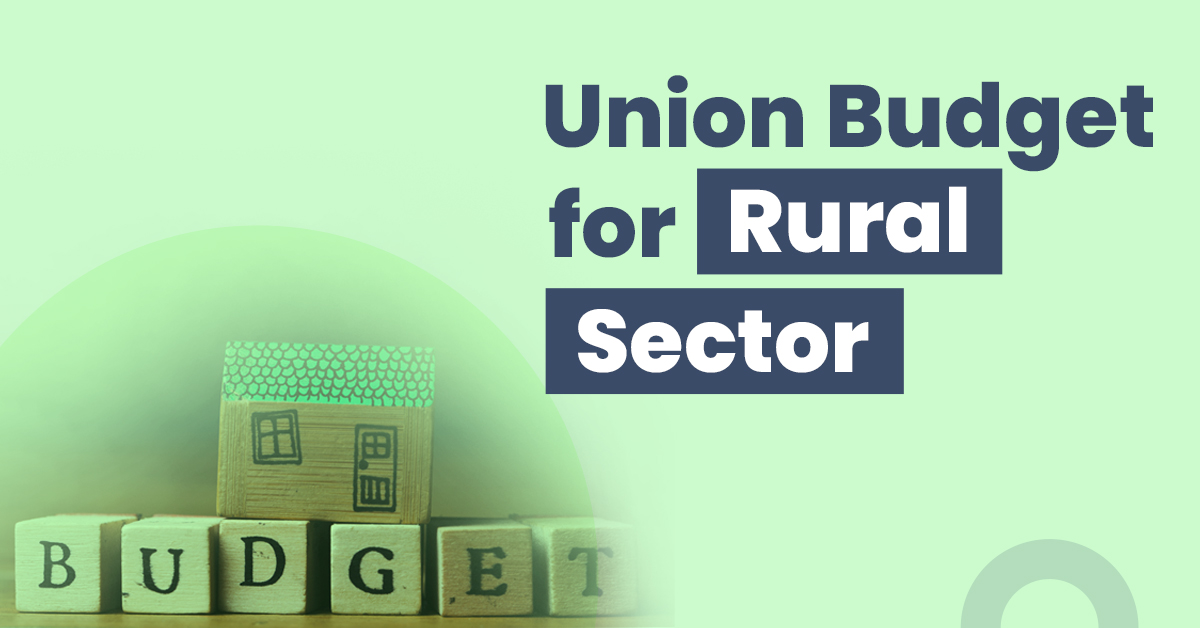Union Budget 2022-23 for the Rural Sector in India


The Union Budget of 2022-23 focused on the development of rural areas in India while keeping in mind the key aspects which need special attention. Prime Minister Narendra Modi has been highly active in taking the initiative and introducing new rural schemes, focusing on the crucial areas that are lacking development.
Read on to know the key allocations in Union Budget 2022 with respect to the agricultural sector.
Rural Sector in India: An Overview
In the past few years, rural areas in India have been witnessing significant growth due to the introduction and implementation of various Central and state schemes. But how effective have they been in terms of overall development?
India’s rural sector is the more significant part of democracy, and it primarily depends on agriculture. It is also the highest contributor to GDP at approximately 54%. In addition, there has been an increase in rural literacy, rapid growth in the service industry, improvement in the rural market as well as an increase in consumer demand.
Rural Sector in Union Budget 2022 – Key Announcements
Union Finance Minister Nirmala Sitharaman has strongly emphasised rural development and upgradation in her highly anticipated budget speech. Here are some of the important measures and schemes announced in the Union Budget with respect to India’s rural sector:
Agriculture
- Emphasis on promotion of chemical-free and organic farming throughout the country. The program will first focus on farmers’ lands in the 5 km wide corridor along river Ganga.
- 163 lakh farmers will receive ₹2.37 lakh crore Direct Benefit Transfer of Minimum Support Price (MSP) for wheat and paddy production. The benefits of DBT will start showing results over a period of 1 to 3 years.
- Supply of needed backup and support for millet production. Additionally, emphasis on post-harvest value addition, branding and marketing of millet products.
New technology
- Support for promotion of ‘Kisan Drones’ for crop assessment, spraying of insecticides and nutrients and digitisation of land records.
- Expansion of ‘one class-one TV channel’ program of PM eVIDYA from 12 to 200 television channels.
- Initiative to lay optic fibre in all villages across the country by 2025 under the Bharatnet project through a public-private partnership.
- Measures taken to reduce carbon dioxide emission of up to 35 MMT by mandating mixing of 5 to 7 percent of biomass pellets in the thermal power plants.
Schemes & Programs
- Schemes for higher production of oil seeds resulting in reduced dependence on import.
- Enhancing village programs for the barely populated village areas in North India.
- Packages announced for production and harvesting techniques for fruits and vegetables.
- Allocation of ₹73,000 crore for the Mahatma Gandhi National Rural Employment Guarantee Program for development of employment opportunities.
- Allocation of ₹2,000 crore for livestock health and disease control programme, which is higher than the previous year’s budget of ₹1470 crore.
- Pradhan Mantri Kisan Sampada Yojana has got an allocation of ₹ 900 crore.
- Allocation of ₹60,000 crore for the Har Ghar Jal Scheme of the Central Government.
- The Pradhan Mantri Gram Sadak Yojna has received a funding of ₹19,000 crore.
- Allocation of₹12,954 crore for the Pradhan Mantri Krishi Sinchan Yojana.
- Allocation of ₹7192 crore for the Swachh Bharat Mission (Gramin)
- Emphasis on revising the syllabi of agricultural universities to meet the needs of modern-day agriculture, value addition and management, natural, zero-budget and organic farming.
- Post offices in rural areas will now be brought under core banking making money transfer possible from post office accounts to other bank accounts.
Shortcomings of the Union Budget in Relation to the Rural Sector
Many initiatives and schemes have been introduced after assessing the essential pointers which need significant improvement. However, some areas of the rural sector might have benefitted from an increase in allocation.
Here are some of the deficiencies of the latest Union Budget:
- Funds allotted for ‘LPG Connection to Poor Households’ has been cut short in half, making it ₹800 crore from the previous year’s ₹1618 crore.
- In the agriculture sector, fund allocation for the farmer’s crop insurance scheme has been reduced to ₹15,500 crores from previous year’s ₹15,989 crore.
- Allocation of urea subsidy has been reduced from ₹75,930 crore to ₹63,222.
Implications of the Budget Allocation on the Rural Sector
More than half of our country’s population is dependent on agriculture, either directly or indirectly, which also has a massive impact on our economy. Hence, development and advancement in this sector is crucial to boost our country’s economy. The Union Budget 2022 has focused on agriculture and its associated activities, which will hopefully have a positive impact on the growth of the rural economy.
Final Words
With enhanced purchasing power, innovative technologies, laying of optic fibre, increased literacy rate and many other improvements on the way, it can be said that the Union Budget 2022-23 has set an encouraging pathway for the development of India’s rural sector.
Frequently Asked Questions
What is the objective of ‘Amrit Kaal’?
First introduced by Prime Minister Narendra Modi in 2021, the objective of Amrit Kaal is to improve the lives of people of India and make developments in villages on par with that of the cities by introducing the latest technological advancements.
What is the purpose of the DESH STACK e-portal?
The main purpose of the DESH STACK e-portal is to provide skilling, upskilling and reskilling prospects to citizens through API-based platforms, making them capable of earning their own livelihood. In addition, this portal also helps to discover job and entrepreneurial opportunities.
What are the departments under the Ministry of Rural Development?
The Ministry of Rural Development is responsible for welfare and development activities in rural areas. This ministry has been further divided into two departments – Land Resources and Rural Development.







